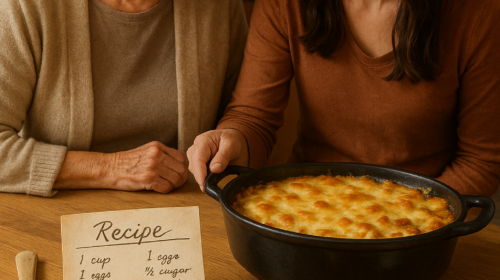I’d been married to Jake for less than a year when I received the first recipe from his mother, Linda. She’d always been a mix of warmth and mystery—endlessly polite, never overly affectionate, and just cryptic enough to keep me on my toes. When her email landed in my inbox, subject line “Famous Family Lasagna,” I smiled, thinking it was a gesture of welcome. But as I read through the recipe, I began to realize there was something more to it than a list of ingredients and steps—a hidden message that would change the way I saw our relationship.
The “Lasagna Letter”
The email started sweetly enough: “Dear Anna, I thought you might enjoy making the lasagna Jake grew up loving. It’s always been a family favorite. Hope you like it!” I opened the attached recipe, prepared to shop for ricotta and noodles, but something about the way she wrote the instructions caught my eye.
She was oddly specific: “Layer noodles carefully—never rush. Every layer matters.” “Simmer sauce on low for exactly 37 minutes—patience is everything.” “Don’t skimp on the cheese—trust me, it makes all the difference.” The tips weren’t just about food. They felt like advice, but not just for cooking.
Then I noticed something else: certain words were bolded. Carefully, exactly, trust me, makes all the difference. Was it a formatting accident? I read the recipe again, and the pattern seemed too deliberate.

Cracking the Code
I printed the email and highlighted each bolded word. Alone, they made little sense, but in order, they formed a kind of mantra:
“Carefully exactly trust me makes all the difference.”
I puzzled over it for a while, then realized Linda wasn’t just teaching me to make lasagna. She was sending me a message about marriage—and about being part of her family.
I thought back to my first holiday with Jake’s family, when I’d accidentally spilled wine on their white tablecloth and nearly burst into tears. Linda had calmly blotted at the stain and said, “It’s just a tablecloth. Some stains come out, some don’t. What matters is that we’re together.” At the time, I thought she was just being nice. Now, I realized she was always gently guiding me, sharing her wisdom in her own subtle way.
A New Perspective
I decided to write back, thanking her for the recipe and asking if she had any other family favorites to share. Her next message came a few weeks later—a recipe for apple pie, with similar little quirks and hints woven throughout. This time, she wrote, “Don’t be afraid to try again if the crust doesn’t come out perfect the first time.”
It was clear: Linda used recipes the way some people use handwritten notes or long conversations. This was her way of connecting, of teaching me that family, marriage, and even something as simple as dinner all require patience, care, and trust.
The Next Family Dinner
The first time I made the lasagna for Jake and Linda, I followed every instruction to the letter. As we ate, Linda asked what I thought of the process. I told her, quietly, that I’d noticed her special advice. She smiled, her eyes sparkling just a bit, and said, “Marriage is like lasagna—messy, layered, and always better with patience and love. Remember that, and you’ll do just fine.”
We both laughed, and for the first time, I felt truly welcomed—not just as Jake’s wife, but as someone Linda cared enough to share her secrets with.
Final Thought
Sometimes, the most important messages aren’t said out loud—they’re baked into the details, shared in recipes, and woven through the rituals of family. If you’re lucky enough to have a mother-in-law who sends you advice with her casseroles, read between the lines. You might find wisdom that makes all the difference.



